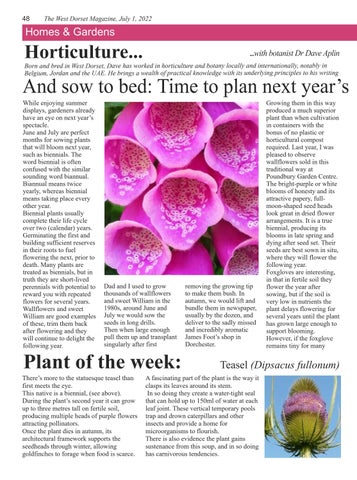48
The West Dorset Magazine, July 1, 2022
Homes & Gardens x
Horticulture...
...with botanist Dr Dave Aplin
Born and bred in West Dorset, Dave has worked in horticulture and botany locally and internationally, notably in Belgium, Jordan and the UAE. He brings a wealth of practical knowledge with its underlying principles to his writing
And sow to bed: Time to plan next year’s While enjoying summer displays, gardeners already have an eye on next year’s spectacle. June and July are perfect months for sowing plants that will bloom next year, such as biennials. The word biennial is often confused with the similar sounding word biannual. Biannual means twice yearly, whereas biennial means taking place every other year. Biennial plants usually complete their life cycle over two (calendar) years. Germinating the first and building sufficient reserves in their roots to fuel flowering the next, prior to death. Many plants are treated as biennials, but in truth they are short-lived perennials with potential to reward you with repeated flowers for several years. Wallflowers and sweet William are good examples of these, trim them back after flowering and they will continue to delight the following year.
Dad and I used to grow thousands of wallflowers and sweet William in the 1980s, around June and July we would sow the seeds in long drills. Then when large enough pull them up and transplant singularly after first
Plant of the week: There’s more to the statuesque teasel than first meets the eye. This native is a biennial, (see above). During the plant’s second year it can grow up to three metres tall on fertile soil, producing multiple heads of purple flowers attracting pollinators. Once the plant dies in autumn, its architectural framework supports the seedheads through winter, allowing goldfinches to forage when food is scarce.
removing the growing tip to make them bush. In autumn, we would lift and bundle them in newspaper, usually by the dozen, and deliver to the sadly missed and incredibly aromatic James Foot’s shop in Dorchester.
Growing them in this way produced a much superior plant than when cultivation in containers with the bonus of no plastic or horticultural compost required. Last year, I was pleased to observe wallflowers sold in this traditional way at Poundbury Garden Centre. The bright-purple or white blooms of honesty and its attractive papery, fullmoon-shaped seed heads look great in dried flower arrangements. It is a true biennial, producing its blooms in late spring and dying after seed set. Their seeds are best sown in situ, where they will flower the following year. Foxgloves are interesting, in that in fertile soil they flower the year after sowing, but if the soil is very low in nutrients the plant delays flowering for several years until the plant has grown large enough to support blooming. However, if the foxglove remains tiny for many
Teasel (Dipsacus fullonum)
A fascinating part of the plant is the way it clasps its leaves around its stem. In so doing they create a water-tight seal that can hold up to 150ml of water at each leaf joint. These vertical temporary pools trap and drown caterpillars and other insects and provide a home for microorganisms to flourish. There is also evidence the plant gains sustenance from this soup, and in so doing has carnivorous tendencies.










